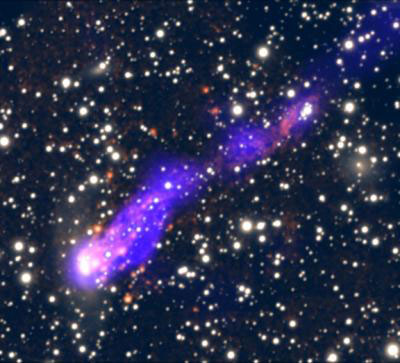Galaxy Sports Vast Comet-Like Tail

Orphaned stars are being bornin a vast tail of material stretching behind a faraway galaxy, astronomers saidtoday.
The finding is evidence thatorphaned stars?those not orbiting the center of a galaxy in normal fashion?aremuch more common than thought.
The feature extends for morethan 200,000 light-years and was created as gas was stripped from the galaxy.For comparison, our solar system is about 26,000 light-years from the centerof the Milky Way, and we're said to be in the galactic outskirts.
"This is one of thelongest tails like this we have ever seen," said Ming Sun of MichiganState University, who led the study. "And, it turns out that this is agiant wake of creation, not of destruction."
Millions of stars
The comet-like tail wasobserved in X-ray light with NASA's Chandra X-ray Observatory and in opticallight with the Southern Astrophysical Research (SOAR) telescope in Chile.
The observations indicate thatthe gas in the tail has formed millions of stars.Because the large amounts of gas and dust needed to form stars are typicallyfound only within galaxies, astronomers had thought it unlikely that largenumbers of stars would form outside a galaxy.
Get the Space.com Newsletter
Breaking space news, the latest updates on rocket launches, skywatching events and more!
"This isn't the firsttime that stars have been seen to form between galaxies,"said team member Megan Donahue, also of MSU. "But the number of starsforming here is unprecedented."
The parent galaxy, called ESO137-001, is about 220 million light-years from Earth. It is plunging toward thecenter of Abell 3627, a giant clusterof galaxies.
The evidence for starformation in the galaxy's tail includes 29 regions of ionized hydrogen glowingin optical light, thought to be from newly formed stars. X-rays emanating fromtwo of these regions also suggest starbirth.
Young stars
The researchers believe theorphan stars formed within the last 10 million years or so. Our sun, forcomparison, is about 4.6 billion years old.
The stars in the tail of thisfast-moving galaxy would be much more isolated than the vast majority of starsin galaxies.
"By our galacticstandards, these are extremely lonely stars," said Mark Voit, another teammember from MSU. "If life was to form out there on a planet a few billionyears from now, they would have very dark skies."
- Top 10 Star Mysteries
- Comet-like Tail Discovered Behind Speeding Star
- The Strangest Things in Space
Join our Space Forums to keep talking space on the latest missions, night sky and more! And if you have a news tip, correction or comment, let us know at: community@space.com.

Space.com is the premier source of space exploration, innovation and astronomy news, chronicling (and celebrating) humanity's ongoing expansion across the final frontier. Originally founded in 1999, Space.com is, and always has been, the passion of writers and editors who are space fans and also trained journalists. Our current news team consists of Editor-in-Chief Tariq Malik; Editor Hanneke Weitering, Senior Space Writer Mike Wall; Senior Writer Meghan Bartels; Senior Writer Chelsea Gohd, Senior Writer Tereza Pultarova and Staff Writer Alexander Cox, focusing on e-commerce. Senior Producer Steve Spaleta oversees our space videos, with Diana Whitcroft as our Social Media Editor.











